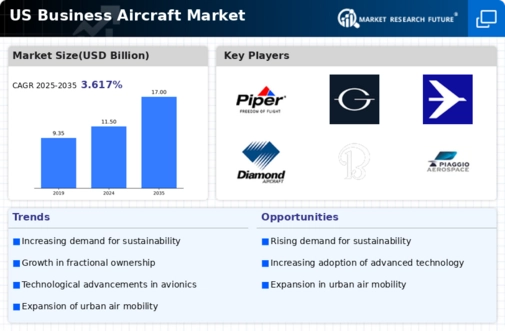Rising Corporate Travel Needs
The business aircraft market is experiencing a surge in demand due to increasing corporate travel needs. As companies expand their operations and seek to enhance productivity, the necessity for efficient travel solutions becomes paramount. In 2025, the market will be projected to grow by approximately 5% annually, reflecting the growing reliance on business aviation for time-sensitive travel. This trend is particularly evident among Fortune 500 companies, which are increasingly investing in private aircraft to facilitate swift and flexible travel arrangements. The ability to reach remote locations and conduct meetings without the constraints of commercial flight schedules is a compelling advantage. This advantage propels the business aircraft market forward.
Evolving Regulatory Environment
The regulatory landscape surrounding the business aircraft market is evolving, with new policies aimed at enhancing safety and environmental standards. The Federal Aviation Administration (FAA) continues to implement regulations that promote the use of advanced safety technologies and operational efficiencies. These regulations not only ensure safer air travel but also encourage manufacturers to innovate, thereby stimulating growth within the business aircraft market. Compliance with these regulations often necessitates upgrades and new purchases, which can lead to increased market activity. As companies adapt to these changes, the business aircraft market is likely to see a shift towards more technologically advanced and environmentally friendly aircraft.
Growing Focus on Time Efficiency
In an era where time is a critical resource, the business aircraft market is benefiting from an increasing focus on time efficiency. Executives and business leaders are prioritizing travel solutions that minimize downtime and maximize productivity. The ability to fly directly to a destination without layovers or delays associated with commercial flights is a compelling factor driving demand. In 2025, it is estimated that the business aircraft market will see a 6% increase in usage as companies recognize the value of time-saving travel options. This emphasis on efficiency is likely to continue shaping the market, as more organizations seek to leverage business aviation for competitive advantage.
Technological Integration in Operations
The integration of advanced technologies into business aircraft operations is transforming how companies manage their aviation needs. Innovations such as artificial intelligence, data analytics, and real-time tracking systems are enhancing operational efficiency and safety. These technologies allow for better route planning, fuel management, and maintenance scheduling, which can lead to significant cost savings. As businesses increasingly adopt these technologies, the demand for modern aircraft equipped with such capabilities is likely to rise. This trend not only improves the overall experience for users but also positions the business aircraft market as a leader in aviation innovation.
Increased Investment in Business Aviation
Investment in the business aircraft market is on the rise, as both private and institutional investors recognize the potential for high returns. In 2025, the market is expected to attract over $20 billion in investments, driven by the growing demand for private jets and charter services. This influx of capital is facilitating the development of new aircraft models and enhancing existing fleets. Furthermore, the trend towards fractional ownership and jet card programs is making business aviation more accessible, thereby broadening the customer base. As investment continues to flow into the sector, the business aircraft market is poised for sustained growth and innovation.



















Leave a Comment